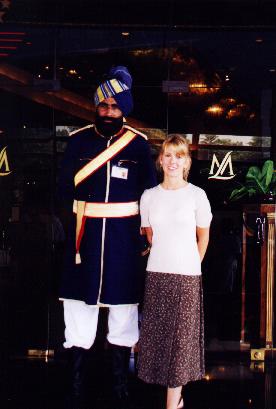
| The infamous snake charmers. Cobras and Pythons abound to entertain the tourists. There were many varied stories spoken about how the charmers actually charm their snakes. From the snakes are drugged, to they are fangless and poisonless, to the rythm of the flute making the snakes mesmorized and unabe to strike. In general it looked like the charmers new how to handle snakes and the snakes where used to the charmers - an entertainment team. |  |
| This is India's main statue. It encompasses all the attributes of the Hindu religion - as it was explained to us. It was incredible to hear about all the symbolism - eminating from all the parts of the statue. It was too much to fully understand and remember. |  |
 |
 |
So much has been written about the significance of India's Monsoon season. We all know that it rains like it's the end of the world. You have to experience it to really "see" what people mean. Even the rickshaw's which never look blurry because they are not what you'd call "speed demons" start to take on a dream-like quality through the rain. |
| There so much water outside that you have to do the "Embassador Tour". That when you see the sites from looking out the window of an old London cabby style "Embassador" sedan. The red Mogul palace in Delhi swims through the rain waterfall window. "Don't worry, there is a better red Mogul palace in Agra, just like this one later on your tour, the tour guide said." We'd get lots of the Hindu basic philosophy of "don't worry, be happy" - there's nothing you can do about it anyway.... |  |
 |
Unlike in other parts of the world, rain in India brings happiness. Why? Well, most everywhere else rain comes with cold. In India rain comes with cool and after suffering months of unbearable heat in a land with little AC it's something that would make you giggle like a school girl too. |
| We were able to venture out a little ad look at some of the ruins of the Mogul presence in Delhi. Most of the historical sites in Delhi have been sacked and destroyed because so many throughout history have taken from past generations to build their own monuments. That's the way it worked in the capital city and most significant of the Indian cities. |  |
 |
Still, the sites are interesting. Red sandstone, we came to see, often, was the most important building material the Mogul's used. It is everywhere. |
*
photos of a Delhi Mogul Tomb that preceded the Taj Mahal
*